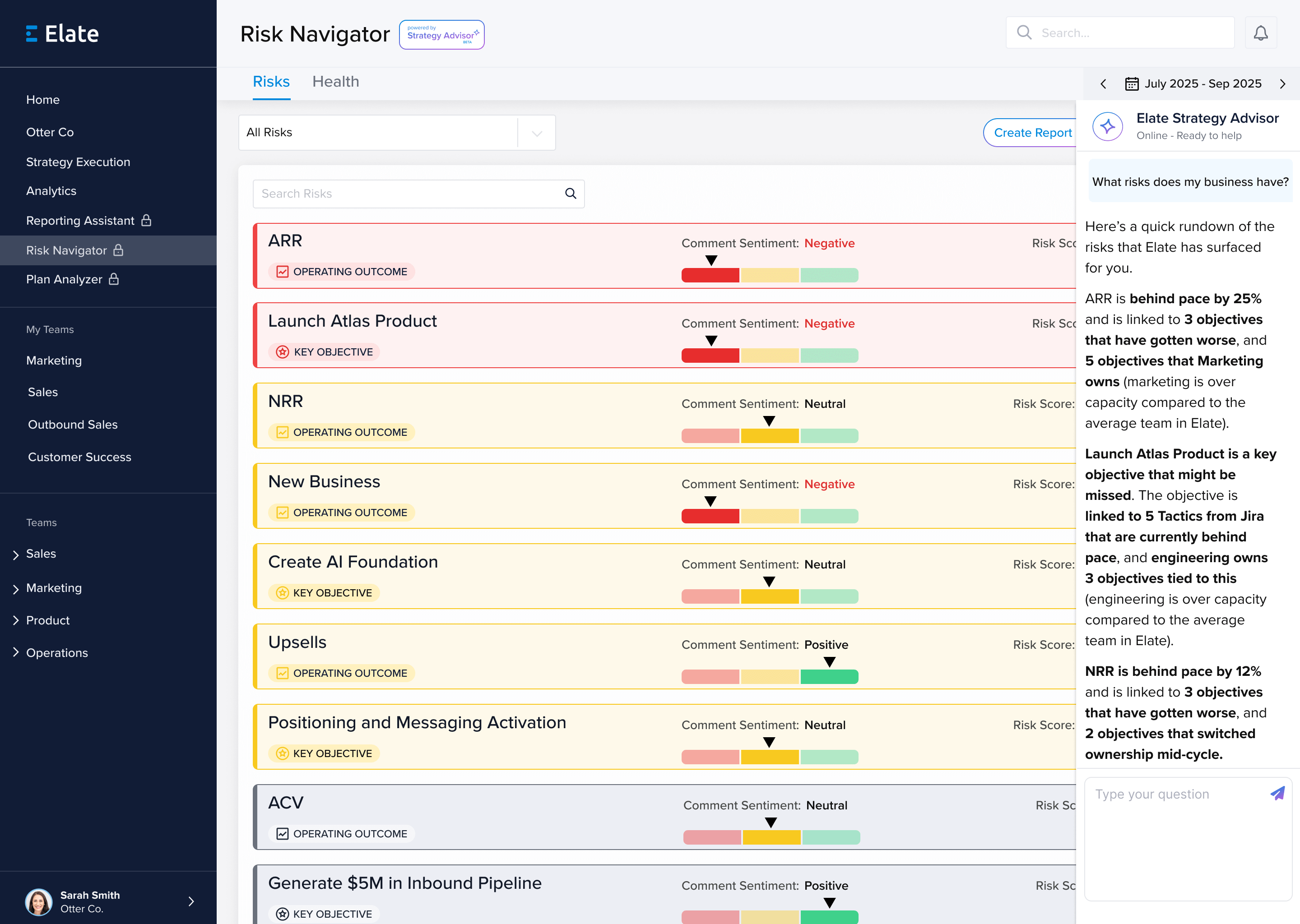There's a difference between goals and objectives, and understanding it has a huge impact on the effectiveness of OKRs for your team.
Many managers at all levels don't understand how to define goals and objectives. The two terms tend to be used interchangeably. Confusing them comes naturally as they both refer to desirable outcomes you want your company to achieve.
Goals and objectives differ, however, in how concrete they are. They differ in the way you measure them. And they differ in the impact they have on your organization in a given time frame, say, the next month, the next quarter, the next year, or the next five years.
Goals and objectives have very different outcomes for your company. That's why it's so important for everyone in your organization, whether it's an office, a branch, a division, or company-wide, to be on the same page with the meanings of these two important terms.
In this article, we'll clear up the distinctions between goals and objectives and help you achieve clarity in company communication.
What are goals? What are some goals examples?
Setting goals is the process of choosing the broad outcomes you want your organization to achieve.
You might use goals in your yearly and quarterly company strategy, your positioning in your market or in competition with other companies, mission statement, company culture guide, financial projections, and other crucial business documents and initiatives. The right goals will align with your company vision, purpose, and long-term aspiration.
You will consider goals as you set your quarterly and annual OKRs. You''ll always take goals into account as you analyze financial projections, or as you write a company conduct guide, or you plan major business initiatives.
Goals are long-term outcomes that can be measured in multiple ways. They have multiple components, and they aren't achieved overnight. A goal is something more on the lines of "Achieve energy efficiency" that "Remember to turn down the thermostat at night at the end of the second shift, especially on Saturday."
Some examples of goals include:
- Foster equitable outcomes in employee career development.
- Focus on delighting customers.
- Build a culture of transparency and communication.
- Build trust between departments.
Goals are big. They're hard to measure. You will never be able to quite put your finger on a measure of success, but you have ways of knowing that you are making progress toward your goals as you meet your objectives.
What are objectives? What are some examples of objectives? What's the difference in the definition of goals and objectives?
Objectives are the clearly defined, time-limited, measurable, tangible steps that your organization must take to meet its goals. They are clearly defined in the sense that everyone can answer the question of "Did we meet this objective?" with a "yes" or a "no." They are time-limited in the sense that they aren't to be achieved "whenever." Objectives come with deadlines. Your organization will accomplish the objective in a week or a month or by the end of the quarter or by the end of the year.
Objectives are measurable. You can attach a number to your key results (the KR in OKR) that tells you how much progress you have made and how much remains to be done. Your progress with your key results helps your managers to prioritize activities across a number of OKRs to keep your company on track for checking off the accomplishment of objectives in the short run that empower goals in the long run.
Both objectives and goals are subject to something management experts call the "time span of discretion." Objectives are a focus of daily, weekly, monthly, and quarterly management of offices, branches, and divisions. Goals are a focus of activities that take years or even decades at a higher level of leadership.
Goals and objectives work together to help you maximize your team's productivity to get the results you want. Creating goals without OKRs, that is, objectives you can measure in key results, gives you great ideas that never get realized. Creating objectives without goals keeps your organization running around in circles.
Let's take a closer look at the fine differences between company goals and objectives examples you need to know.
Definition. A goal is a destination at which your company will arrive. it's the direction you want your company to go. An objective is in an exact step or action your company must take to reach its goals.
Time frame. Goals are achieved long-term. Objectives are met in the short to medium term.
Specificity. Goals are general. Objectives are precise.
Plan. Goals are broad. Objectives are narrow.
Size. Goals cover your entire organization. Objectives involve parts of your organizaiton.
Measurement. Goals are "either we have achieved it or not." Objectives must be measurable.
Actions. Goals can't really be measured, but we all know when we have achieved them. Objectives can be measured in terms of key results. You can measure your progress toward meeting a key result in real time.
Another example of how goals and objectives are different. A goal might be "We will increase our international customer base." An objective might be "We will increase the number of customers we have in Ireland by 32% by the end of this year."
For goals to be actionable, and not just vague dreams of something your company can be, they have to be broken down into objectives, and those objectives have to be operationalized as key results (KRs) and key performance indicators (KPIs).
Your company vision guides your company goals. Your company goals guide your company objectives. Your company objectives are broken down into key results and key performance indicators, and your key results and key performance indicators are evaluated in terms of metrics and measurements.
Here's another example of how that works.
- Your vision for your company is that you will become an international leader in your field.
- Your goal for your company is to increase your international customer base.
- An objective might be to increase the number of customers you have in Australia by 12% in the next three months
- A key result for your outbound sales team might be to reach out to 10 prospects in Australia every week. The metric for this key objective is prospects.
- A key result for your production team might be to reduce average delivery time for customers in Australia by 5 days by the end of this quarter. The metric for this key objective is days to deliver.
- A key result for your online marketing team might be to reduce the cost per click for your ads in Australia from $2.00 to $1.00 by the end of the quarter. The metric for this key objective is cost per click, in dollars.
Every objective has an object. Objects are measurable. This means that objectives can be scoped into budgets and timeframes for your organization's planning. Many organizations use S.M.A.R.T. criteria for linking objectives to goals with objective measurements. S.M.A.R.T. stands for:
- Specific. Objectives specify results that can be counted, such as 10 prospects per week in the example above.
- Measurable. If you can't measure it, it's not an objective. "Make sure our customers in Australia feel all warm and fuzzy inside after they speak with our salespeople" isn't an objective. "Increase sales in Australis by 2!0% this quarter" is an objective.
- Attainable. Objectives must be something your team can actually do. "Increase sales twelive kajillion percent" isn't attainable. "Increase sales by $1 million this quarter" may be attainable.
- Relevant. Objectives need to align with goals, and goals need to align with your company vision. There are desirable results that aren't necessarily results that are critical to your company's goals. You definitely want your employees to feel good about working for you. But that isn't your company's reason for existence and it's not a relevant goals.
- Time-bound. Objectives always go with deadlines. "Eventually" isn't a date on the calendar.
So, how do you connect your objectives to your goals in the real world?
Elate is a suite of team productivity tools that empower you to match your company-wide goals with the objectives and key results that give you feedback on how the part of our company are making progress toward your long-term goals. With Elate, not only can you keep tabs on your employees, you and your employees can stay on the same page with objective feedback on how your company is working to accomplish the key results that confirm the objectives that are needed for the goals that make up your vision for your company.
Elate works with tools like Asana, GitHub, Slack, and Trello. Elate makes it easy to connect your documents, tasks, and codes to track your objectives and key results. You can make objectives pop into life and keep them in line with your goals by giving your employees our OKR app.
Don't let your goals get lost in a tangle of competing objectives. Keep your company on track day by day, and week by week to meet your long-term goals with Elate.











